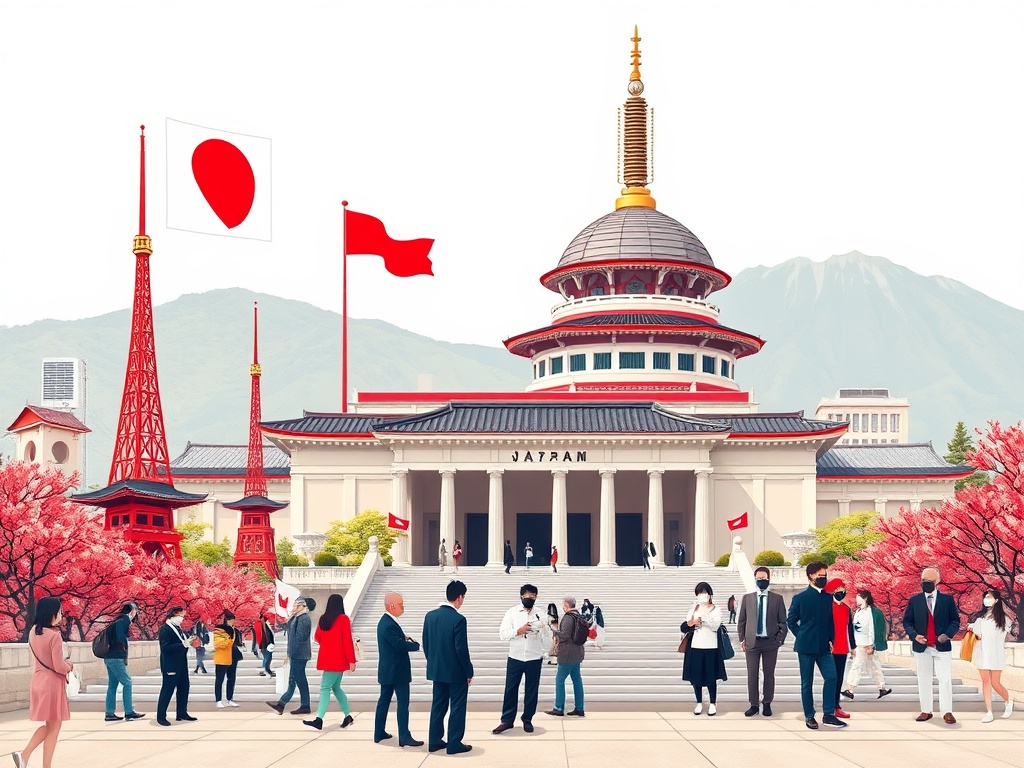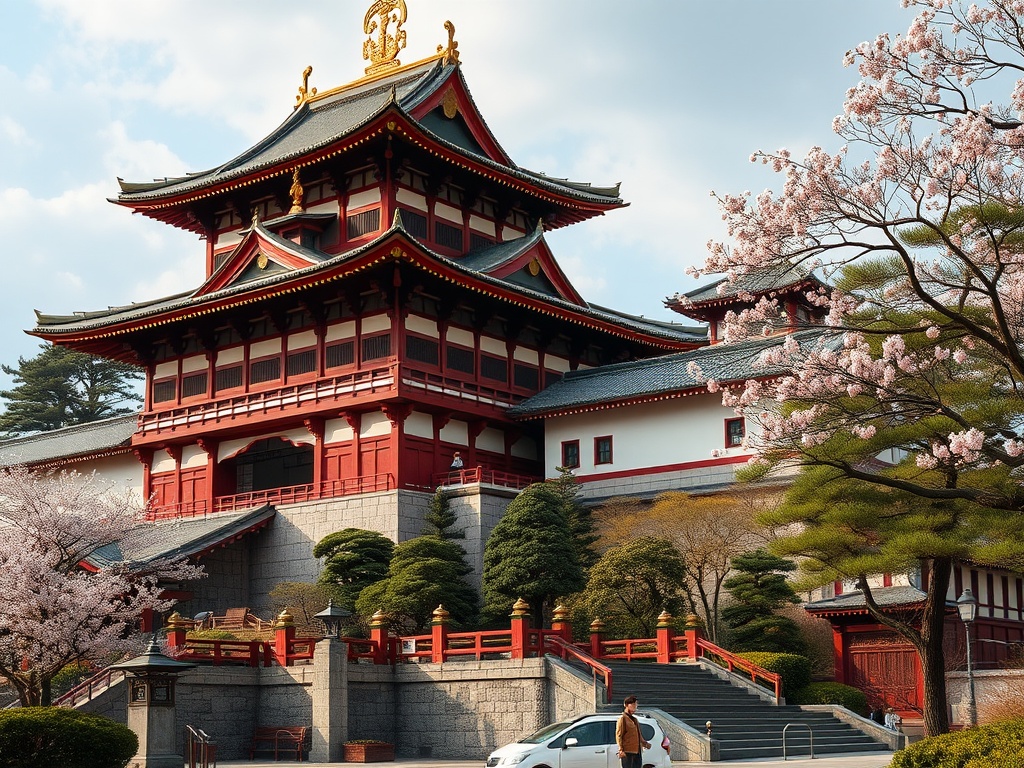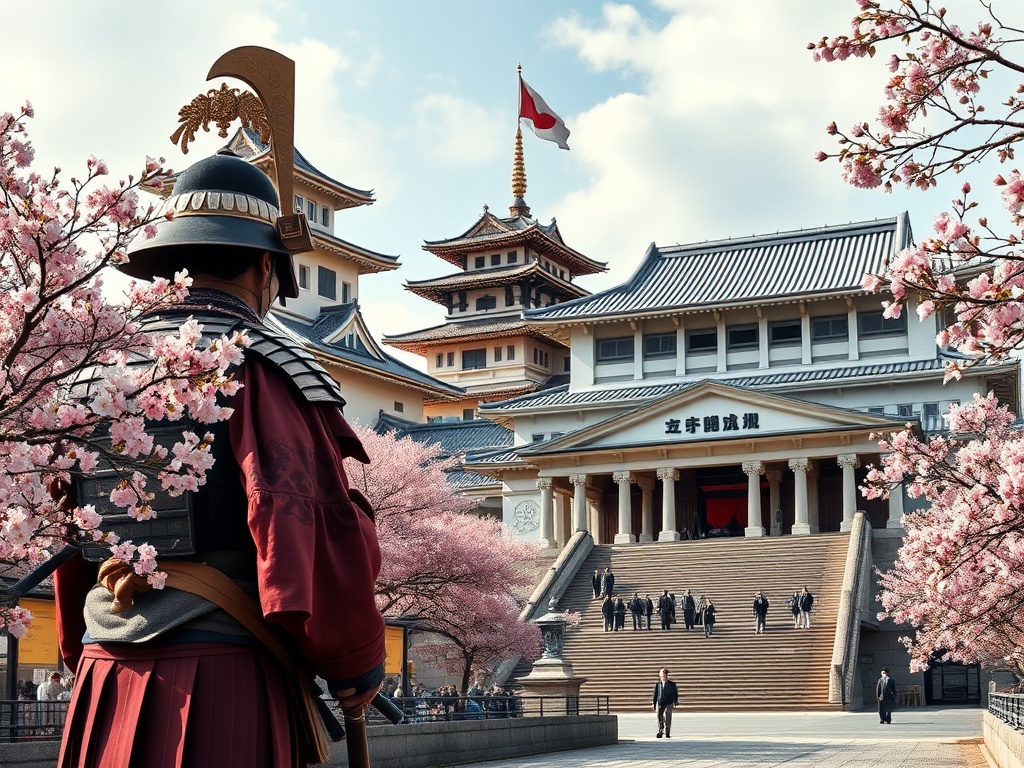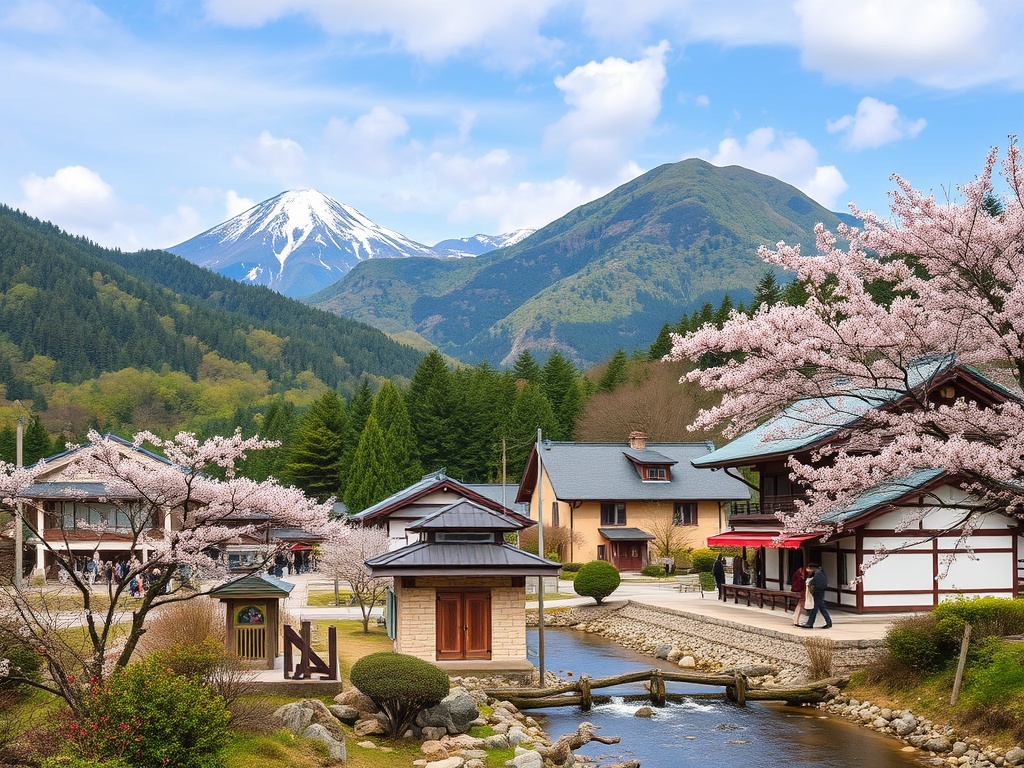The Chrysanthemum Throne: A Royal Journey through Japan’s Constitutional Monarchy
Win a Free Trip to Japan!
Experience cherry blossoms and ancient temples
Japan’s political tapestry is interwoven with tradition and modernity, embodied in the symbolic significance of the Chrysanthemum Throne. This journey through Japan’s constitutional monarchy invites travel and tourism enthusiasts to explore the unique blend of imperial history and democratic governance that defines the Land of the Rising Sun. From the bustling streets of Tokyo to the serene gardens of Kyoto, the Emperor’s role as a ‘symbol of the State and of the unity of the people’ offers a fascinating lens into Japan’s cultural and political identity.
The Imperial Family of Japan, the world’s oldest hereditary monarchy, has a rich historical legacy that captivates visitors. As the custodians of Japanese culture, the family plays a pivotal role in preserving ancient traditions while embracing the challenges of the contemporary era. The current Emperor, Naruhito, continues this legacy, with the Chrysanthemum Throne symbolizing peace and continuity.
While the Emperor holds a ceremonial role, Japan’s political landscape is driven by democratic processes. The country’s constitutional monarchy ensures that the government operates under a parliamentary system, with the Prime Minister and elected officials managing the day-to-day affairs. This section provides insights into the intriguing balance between imperial symbolism and democratic governance, offering travelers a deeper understanding of Japan’s political framework.
Key Attractions for Enthusiasts:
- Imperial Palace, Tokyo: Witness the elegance and history of the Emperor’s primary residence, surrounded by picturesque gardens.
- Kyoto Imperial Palace: Discover the former seat of the Emperor, reflecting Japan’s rich heritage and architectural prowess.
- Meiji Shrine, Tokyo: A serene oasis dedicated to Emperor Meiji, symbolizing the fusion of tradition and modernity.
From Samurai to Senators: The Evolution of Japan’s Bicameral Parliament
Journey through Japan’s fascinating political evolution, where the echoes of a feudal past resonate within the corridors of modern governance. The transformation from a society ruled by samurai to a nation governed by democratic principles is a story of resilience, adaptation, and cultural synthesis. In this exploration, travel and tourism enthusiasts are invited to delve into the intricate tapestry of Japan’s bicameral parliament, a system that embodies the spirit of a nation embracing both its storied past and promising future.
In the late 19th century, Japan’s transition from a shogunate to a constitutional monarchy laid the groundwork for its parliamentary structure. The establishment of the House of Peers in 1889 marked a pivotal moment, drawing inspiration from European models while maintaining distinct Japanese elements. This upper chamber was a symbol of continuity, with its membership comprising former daimyo, noblemen, and esteemed scholars. For travelers, visiting historical sites like the National Diet Building in Tokyo offers a deeper appreciation of how this legacy of leadership has evolved, highlighting the unique blend of tradition and modernity that defines Japan’s political landscape.
Today, the National Diet, or Kokkai, stands as a testament to Japan’s commitment to democratic ideals. Comprising the House of Representatives and the House of Councillors, the Diet serves as the epicenter of legislative activity. The lower house, with its elected officials, reflects the will of the people, while the upper house ensures a balance of power and expertise. Visitors to Tokyo can explore this dynamic arena of political discourse, where debates and decisions shape the future of the nation. The vibrant atmosphere of the Diet captures the essence of Japan’s democratic journey, offering tourists a unique window into the workings of a modern parliamentary system.
As you immerse yourself in the evolving narrative of Japan’s bicameral parliament, you’ll uncover stories of reform, resilience, and renewal that continue to influence the nation’s path forward. From the historic roots of the samurai to the progressive policies of today’s senators, Japan’s democratic evolution is a compelling tale of cultural convergence and political innovation.
Voting with a View: How Japan’s Electoral System Shapes Its Scenic Democracy
Japan’s electoral system is a captivating journey through a land where ancient traditions meet vibrant democracy. The country’s political landscape is not just a tapestry of policies and parties but a scenic route that offers travelers a unique perspective on how electoral dynamics shape the nation’s cultural and geographical identity. From the urban sprawl of Tokyo to the tranquil beauty of rural areas, the electoral process is an integral part of Japan’s democratic framework, influencing both urban development and rural preservation.
In Japan, electoral districts are more than just geographic boundaries; they are the heartbeat of local democracy, reflecting the diverse tapestry of communities across the archipelago. Each district represents a unique blend of cultural heritage and modern aspirations, offering travelers a glimpse into how regional identities are preserved within the national narrative. Visitors exploring these districts will find a fascinating intersection of traditional customs and contemporary political engagement, showcasing the resilient spirit of the Japanese people as they navigate their democratic journey.
The introduction of proportional representation in Japan’s electoral system marks a significant shift towards inclusivity and balance, ensuring that diverse voices are heard in the halls of power. This system allows for a more equitable representation of political parties, providing a platform for smaller groups to influence national policy. For tourists, understanding this system offers a deeper appreciation of how Japan harmonizes its historic past with modern governance, creating a political landscape that is as dynamic and multifaceted as its scenic vistas.
Japan’s electoral system is a testament to its commitment to democratic ideals, blending ancient cultural practices with modern political innovation. As you traverse this captivating land, you’ll discover how the rhythm of elections echoes through its scenic landscapes, shaping the nation’s path forward while preserving its cherished heritage.
Political Cherry Blossoms: Party Dynamics in the Land of the Rising Sun
As the cherry blossoms paint the landscape with their ephemeral beauty, Japan’s political scene unfolds with a similar vibrancy. The intricate web of party dynamics in this constitutional monarchy reflects a dynamic interplay of tradition and progress. For travel and tourism enthusiasts, understanding these political currents offers a deeper connection to the cultural and historical narratives that shape this fascinating nation.
Japan’s political parties have evolved significantly since the end of World War II, blossoming into a vibrant multiparty system. This evolution mirrors the country’s broader journey from post-war recovery to economic powerhouse. The Liberal Democratic Party (LDP), a dominant force since its inception in 1955, has often been at the helm, steering Japan through decades of change. Meanwhile, the opposition parties, like the Constitutional Democratic Party of Japan (CDP) and the Japan Innovation Party, provide a rich tapestry of alternative visions, engaging citizens in a democratic dialogue that shapes national policy.
- Liberal Democratic Party (LDP): Known for its pragmatic approach, the LDP has been influential in defining Japan’s economic and foreign policies.
- Constitutional Democratic Party of Japan (CDP): A progressive force advocating for social welfare and civil liberties, challenging the status quo.
- Komeito: Aligning with the LDP, this party emphasizes peace and human rights, rooted in Buddhist values.
The political landscape is as diverse as Japan’s geography, with each party representing distinct ideologies and regions. By exploring these dynamics, travelers can gain insights into how local and national interests are balanced in this modern democracy.
In Japan, election campaigns are lively spectacles akin to traditional festivals, where candidates take to the streets with colorful banners and enthusiastic speeches. These campaigns are deeply rooted in the cultural ethos of respect and decorum, yet they pulse with the energy of a society eager to participate in its governance. For tourists, witnessing an election campaign offers a unique cultural experience, revealing the passionate engagement of the Japanese people in their democratic process.
As you traverse the land of the rising sun, let the political cherry blossoms guide your journey through Japan’s democratic system—a landscape as rich and varied as the nation itself.
The Emperor’s New Role: Symbolism and Reality in Modern Japanese Politics
In the heart of Japan’s democratic framework lies the Chrysanthemum Throne, a beacon of tradition and cultural heritage. For travel and tourism enthusiasts, understanding the Emperor’s role in modern Japanese politics offers a unique lens into the nation’s evolving identity. The Emperor, once a powerful figure in the shogunate era, now embodies a symbolic presence, representing the unity and continuity of the Japanese people.
With his ceremonial duties, the Emperor serves as a cultural ambassador, seamlessly uniting Japan’s rich past with its dynamic present. As you explore the imperial sites, such as the Imperial Palace in Tokyo and the Kyoto Imperial Palace, you’ll witness the intricate dance of tradition and modernity. The Chrysanthemum Throne, while no longer a seat of political power, remains a cherished symbol of national identity, offering visitors a glimpse into the heart of Japan’s storied history.
In Japan’s constitutional monarchy, the Emperor relinquishes political authority to elected officials, yet his presence is profound. As a unifying figure, he plays a crucial role in ceremonial events and state functions, reinforcing the cultural tapestry of the nation. For tourists, engaging with this aspect of Japanese governance reveals how the Emperor’s role, though largely symbolic, weaves a narrative of continuity and peace within the fabric of a parliamentary democracy. This unique blend of tradition and political innovation is a fascinating aspect of Japan’s governance, inviting travelers to appreciate the subtleties of its democratic evolution.
Local Legends: Understanding Japan’s Unique Prefectural Governance
Embark on a journey through the vibrant mosaic of Japan’s prefectural governance, where local legends and traditions intertwine with the country’s modern democratic framework. Each of Japan’s 47 prefectures offers a unique perspective on how regional identities are preserved and celebrated within the broader narrative of national governance. For travel and tourism enthusiasts, exploring the nuances of Japan’s prefectural system provides an enriching experience, revealing the delicate balance between autonomy and unity that defines this captivating land.
Japan’s prefectural governance is a fascinating tapestry woven from the threads of historical tradition and contemporary administration. Each prefecture enjoys a degree of autonomy, allowing for the preservation of local customs and the implementation of policies tailored to regional needs. This system empowers local governments to address unique challenges and opportunities, fostering a sense of pride and identity among residents. For visitors, this means experiencing a diverse array of cultural practices, culinary delights, and local festivals that vary from one prefecture to another, offering a rich tapestry of experiences.
Discover the distinctive charm of Japan’s prefectures with this curated list of must-visit destinations, each offering a glimpse into the unique governance and cultural heritage of the region:
- Hokkaido: Known for its breathtaking natural landscapes, Hokkaido boasts a robust regional administration that supports sustainable tourism and conservation efforts.
- Kyoto: With its deep historical roots, Kyoto’s local governance focuses on preserving cultural heritage while promoting modern innovation.
- Okinawa: This island prefecture showcases its unique Ryukyu heritage, with local policies aimed at cultural preservation and regional development.
- Fukuoka: A dynamic hub of commerce and culture, Fukuoka’s governance emphasizes economic growth and community engagement.
In Japan, local governance is not just about administration but an active engagement with citizens. Prefectural governments often hold town hall meetings and public forums, encouraging residents to voice their opinions and participate in decision-making processes. This participatory approach ensures that local policies reflect the needs and aspirations of the community, creating a dynamic and responsive governance structure. For tourists, witnessing these democratic practices provides a deeper understanding of how local governance shapes the everyday lives of Japanese citizens, reinforcing the country’s commitment to democratic ideals.
The Art of Consensus: Delving into Japan’s Political Decision-Making Process
Japan’s democratic system is a complex yet harmonious blend of tradition and modern governance. At the heart of this system lies an intricate process of consensus-building, a distinctive approach that shapes the nation’s political landscape. For travel and tourism enthusiasts, exploring this unique decision-making process offers an insightful glimpse into how Japan navigates its democratic journey while maintaining cultural cohesion and unity.
In Japan, political decisions are often reached through a methodical process that prioritizes consensus over confrontation. This approach, deeply rooted in Japanese culture, involves extensive discussions and negotiations among stakeholders to reach a mutually agreeable outcome. The emphasis on harmony is reflected in the political arena, where parties and officials strive to balance diverse viewpoints while crafting policies that resonate with the collective will of the people. As you explore Japan, you’ll find that this consensus-driven ethos permeates various aspects of society, offering a unique perspective on how cooperation and collaboration are integral to the country’s governance.
Understanding the nuances of Japan’s political decision-making process can enhance your travel experience, offering a deeper appreciation for the country’s democratic practices. Here are some of the key elements that define Japan’s consensus-building approach:
- Nemawashi: This traditional practice involves laying the groundwork for decision-making by informally consulting all parties and gathering input before formal discussions begin. It’s a vital step in ensuring that everyone feels heard and included.
- Ringi System: In this system, proposals circulate among all relevant stakeholders for feedback and approval, allowing for a collaborative refinement process that aligns with consensus principles.
- Facilitated Dialogue: Facilitators often guide discussions to ensure that all voices are considered, helping to mediate conflicts and build consensus among diverse groups.
For tourists, witnessing Japan’s consensus-based decision-making process in action can be an enlightening experience. From local town hall meetings to national policy debates, observing how consensus is reached offers a fascinating window into the cultural fabric of the nation. As you traverse through Japan’s vibrant cities and serene countrysides, take a moment to appreciate how this art of consensus shapes not only political outcomes but also social interactions and community dynamics.



